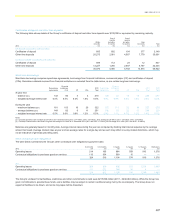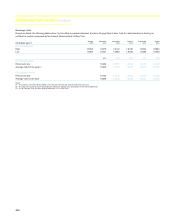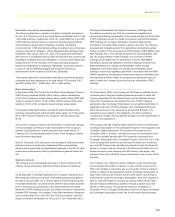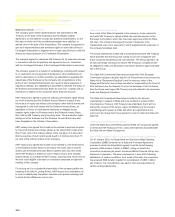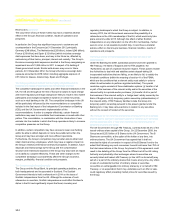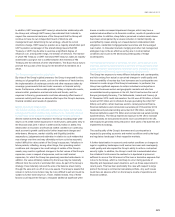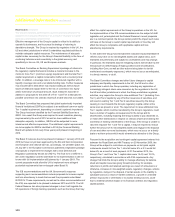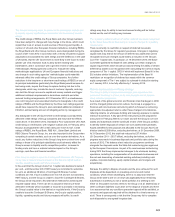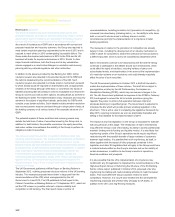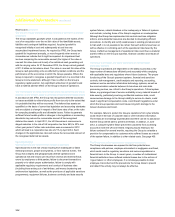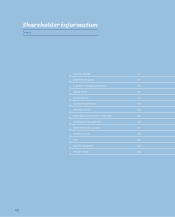RBS 2012 Annual Report Download - page 509
Download and view the complete annual report
Please find page 509 of the 2012 RBS annual report below. You can navigate through the pages in the report by either clicking on the pages listed below, or by using the keyword search tool below to find specific information within the annual report.
RBS GROUP 2012
507
In addition, to the extent that other jurisdictions where the Group operates
have introduced or plan to introduce similar compensation, contributory or
reimbursement schemes (such as in the US with the Federal Deposit
Insurance Corporation), the Group may make further provisions and may
incur additional costs and liabilities, which may have an adverse impact
on its financial condition and results of operations.
The Group may be required to make further contributions to its pension
schemes if the value of pension fund assets is not sufficient to cover
potential obligations
The Group maintains a number of defined benefit pension schemes for
past and a number of current employees. Pension risk is the risk that the
assets of the Group’s various defined benefit pension schemes which are
long-term in nature do not fully match the timing and amount of the
schemes’ liabilities, as a result of which the Group is required or chooses
to make additional contributions to the schemes. Pension scheme
liabilities vary with changes to long-term interest rates, inflation,
pensionable salaries and the longevity of scheme members as well as
changes in applicable legislation. The schemes’ assets comprise
investment portfolios that are held to meet projected liabilities to the
scheme members. Risk arises from the schemes because the value of
these asset portfolios, returns from them and any additional future
contributions to the schemes, may be less than expected and because
there may be greater than expected increases in the estimated value of
the schemes’ liabilities. In these circumstances, the Group could be
obliged, or may choose, to make additional contributions to the schemes,
and during recent periods, the Group has voluntarily made such
contributions to the schemes. Given the recent economic and financial
market difficulties and the prospect that they may continue over the near
and medium term, the Group may experience increasing pension deficits
or be required or elect to make further contributions to its pension
schemes and such deficits and contributions could be significant and
have an adverse impact on the Group’s results of operations or financial
condition. The most recent funding valuation, at 31 March 2010 was
agreed during 2011. It showed the value of liabilities exceeded the value
of assets by £3.5 billion at 31 March 2010, a ratio of assets to liabilities of
84%.
In order to eliminate this deficit, the Group will pay additional
contributions each year over the period 2011 until 2018. Contributions
started at £375 million per annum in 2011, will increase to £400 million
per annum in 2013 and from 2016 onwards will be further increased in
line with price inflation. These contributions are in addition to the regular
annual contributions of around £250 million for future accrual of benefits.
Funding, liquidity and capital related risks
The Group’s ability to meet its obligations including its funding
commitments depends on the Group’s ability to access sources of
liquidity and funding
Liquidity risk is the risk that a bank will be unable to meet its obligations,
including funding commitments, as they fall due. This risk is inherent in
banking operations and can be heightened by a number of factors,
including an over reliance on a particular source of wholesale funding
(including, for example, short-term and overnight funding), changes in
credit ratings or market-wide phenomena such as market dislocation and
major disasters. Credit markets worldwide, including interbank markets,
have experienced severe reductions in liquidity and term-funding during
prolonged periods in recent years. Although credit markets generally
improved during 2012 (in part as a result of measures taken by the ECB),
and the Group’s overall liquidity position remained strong, certain
European banks, in particular from the peripheral countries of Spain,
Portugal, Greece, Italy and Ireland, remained reliant on central banks as
one of their principal sources of liquidity and central banks increased their
support to banks with the ECB providing significant short and long-term
liquidity in the last few months of 2011 and in 2012. Although these
efforts had a positive impact, global credit markets remain volatile.
The market perception of bank credit risk has changed significantly as a
result of the financial crisis and banks that are deemed by the market to
be riskier have had to issue debt at a premium. Any uncertainty regarding
the perception of credit risk across financial institutions may lead to
reductions in levels of interbank lending and associated term maturities
and may restrict the Group’s access to traditional sources of liquidity or
increase the costs of accessing such liquidity.
The Group’s liquidity management focuses, among other things, on
maintaining a diverse and appropriate funding strategy for its assets in
line with the Group’s wider strategic plan. The Group has, at times, been
required to rely on shorter-term and overnight funding with a consequent
reduction in overall liquidity, and to increase its recourse to liquidity
schemes provided by central banks. Such schemes require the pledging
of assets as collateral and changes to asset valuations or eligibility
criteria can negatively impact the available assets and reduce available
liquidity access particularly during periods of stress when such lines may
be needed most. Although conditions have improved, there have been
recent periods where corporate and financial institution counterparties
have reduced their credit exposures to banks and other financial
institutions, limiting the availability of these sources of funding. Increased
competition for funding during 2013 due to the significant levels of
refinancing expected to be required by financial institutions, may also
reduce the level of funding available from these sources. Under certain
circumstances, the Group may need to seek funds from alternative
sources potentially at higher costs than has previously been the case or
may be required to consider disposals of other assets not previously
identified for disposal to reduce its funding commitments.
The Group relies increasingly on customer deposits to meet a
considerable portion of its funding and it is actively seeking to increase
the proportion of its funding represented by customer deposits. The level
of deposits may fluctuate due to certain factors outside the Group’s
control, such as a loss of confidence, increasing competitive pressures
for retail customer deposits or the encouraged or mandated repatriation
of deposits by foreign wholesale or central bank depositors, which could
result in a significant outflow of deposits within a short period of time.
There is currently heavy competition among UK banks for retail customer
deposits, which has increased the cost of procuring new deposits and
impacted the Group’s ability to grow its deposit base and such
competition is expected to continue. An inability to grow, or any material
decrease in, the Group’s deposits could, particularly if accompanied by
one of the other factors described above, have a materially adverse
impact on the Group’s ability to satisfy its liquidity needs.
The occurrence of any of the risks described above could have a material
adverse impact on the Group’s financial condition and results of
operations.


